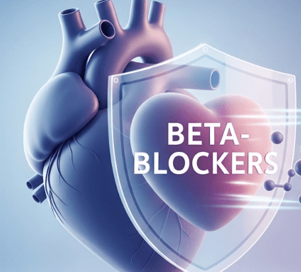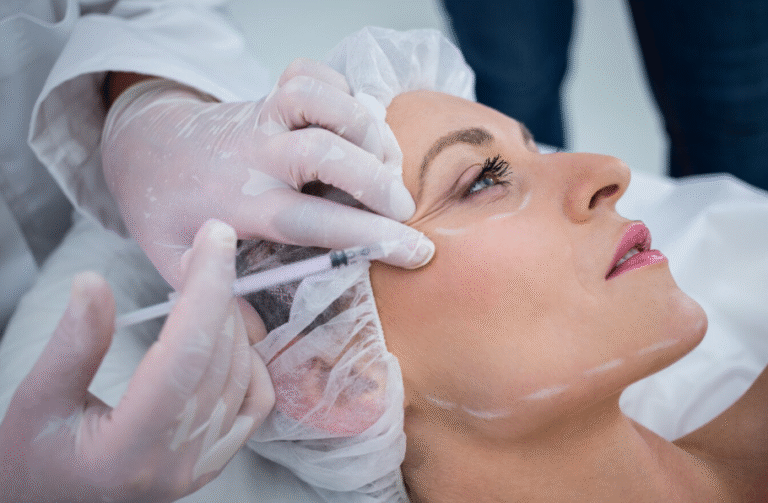Treatment Overview
Beta-blockers are an emerging systemic option in Korea for patients with persistent redness and flushing caused by rosacea, vascular sensitivity, or anxiety-related blushing. Unlike lasers or antibiotics, beta-blockers (commonly propranolol and carvedilol) work by reducing the vascular reactivity and adrenaline-driven flushing response, making them particularly helpful for patients with stress-triggered or heat-induced redness.
In Korean dermatology practice, beta-blockers are often prescribed in low doses to minimize systemic side effects, and usually integrated into combination programs with lasers, soothing infusions, and barrier repair care. They are not a first-line treatment, but are increasingly considered for patients whose flushing is severe or socially disabling.
For redness and flushing, Beta-Blocker Therapy:
- Reduces adrenaline-driven facial flushing.
- Decreases frequency and intensity of heat or stress-related redness.
- Stabilizes vascular reactivity in rosacea patients.
- Improves quality of life for patients with blushing or facial vascular sensitivity.
Purpose & Benefits
- Flushing Control: Reduces episodes of intense redness triggered by stress, alcohol, or heat.
- Vascular Stability: Lowers capillary reactivity and skin temperature surges.
- Adjunctive Role: Complements lasers and antibiotics for rosacea.
- Quality of Life: Helps patients with socially impairing blushing or chronic flushing.
- Long-Term Balance: Maintains vascular calmness when used carefully under supervision.
Ideal Candidates
Beta-Blocker Therapy in Korea is recommended for:
- Patients with severe, frequent flushing due to rosacea.
- Individuals with stress-induced blushing or performance-related redness.
- Those with heat, alcohol, or spicy food-triggered vascular sensitivity.
- Adults whose redness persists despite topical or laser therapies.
- Patients seeking systemic therapy for vascular stability.
Comparison with Other Treatments
- Beta-Blockers (Propranolol, Carvedilol): Best for adrenaline/stress-triggered flushing and vascular stability.
- Antibiotics (Doxycycline, Minocycline): Reduce inflammation, papules, and erythema; less direct on flushing.
- Anti-Redness Lasers (PDL, V-Beam, Nd:YAG): Directly shrink visible vessels; strongest effect on persistent redness.
- Topical Creams (Brimonidine, Oxymetazoline): Temporarily constrict vessels; short-term redness relief.
- Barrier Repair Creams (Centella, Panthenol): Strengthen skin but no vascular suppression.
- LED/Light Therapies: Supportive for inflammation, weaker against vascular triggers.
Possible Risks & Complications
While effective, beta-blockers can cause:
- Fatigue and low energy.
- Dizziness or lightheadedness.
- Slower heart rate and low blood pressure.
- Cold hands and feet.
- Rare worsening of asthma or breathing issues.
Because of these risks, Korean dermatologists typically prescribe low, carefully monitored doses for dermatology-related redness.
Treatment Techniques Used
- Oral Beta-Blockers: Low-dose propranolol or carvedilol prescribed.
- Frequency: Daily or on-demand before trigger situations (e.g., events causing stress flushing).
- Combination Therapy: Used alongside laser, antibiotics, or soothing infusions.
- Clinic Integration: Korean dermatology clinics often combine beta-blockers with anti-redness laser sessions for synergistic effects.
Recovery & Aftercare
- First Week: Flushing frequency decreases noticeably.
- 2–4 Weeks: Improved stability in vascular response.
- Maintenance: Continued low-dose use or situational use as prescribed.
Aftercare Tips:
- Monitor blood pressure and heart rate regularly.
- Avoid alcohol and high caffeine intake when taking beta-blockers.
- Do not stop abruptly—taper under medical supervision.
- Maintain supportive skincare with gentle cleansers and barrier creams.
Results & Longevity
- Short-Term (Days–1 Week): Reduced stress or trigger-induced flushing.
- Medium-Term (1–2 Months): More stable complexion and reduced anxiety about blushing.
- Long-Term: Sustained vascular calmness with consistent use, often combined with laser or topical maintenance.
Treatment Process in Korea
- Consultation & Diagnosis – Dermatologist evaluates flushing triggers, medical history, and cardiovascular health.
- Prescription – Propranolol or carvedilol prescribed in low doses.
- Usage Instruction – Either daily low-dose regimen or situational/on-demand dosing.
- Clinic Add-Ons – Anti-redness laser, cooling therapy, or soothing infusions added for stronger results.
- Follow-Up – Blood pressure and response monitored, dosage adjusted for safety.
Why Korea is a Top Destination
- Korean dermatologists specialize in integrating systemic and topical care for redness.
- Low-dose beta-blocker regimens minimize risks while controlling flushing.
- Often combined with advanced laser technology (PDL, V-Beam, Nd:YAG).
- Cost-effective compared to Western private clinics.
- Holistic skin programs: stress management, soothing infusions, and barrier repair included.
Cost Range (Detailed Breakdown)
Pricing for Beta-Blocker Therapy in Korea for redness & flushing:
- Consultation Fee: USD 20 – 50.
- Prescription Beta-Blockers (1 Month Supply): USD 10 – 30.
- Monitoring (Blood Pressure/Checkups): USD 20 – 50 per visit.
- Combination Clinic Session (Beta-Blocker + Laser/Infusion): USD 100 – 250.
- Premium Vascular Control Program (Beta-Blocker + Laser + Barrier Therapy): USD 700 – 1,500 (3–5 sessions).
Additional Costs in Korea:
- Barrier creams and sensitive-skin moisturizers: USD 30 – 80.
- Sunscreens for redness-prone skin: USD 20 – 50.
💡 Patients often call beta-blockers the “internal calming pill,” since they stabilize the body’s overactive flushing response and restore confidence in daily life.
Popular Clinics in Seoul
- Oracle Dermatology – Beta-blockers + V-Beam laser for rosacea flushing.
- Banobagi Dermatology – Customized redness programs with systemic + laser care.
- Renewme Skin Clinic – Low-dose propranolol combined with topical and infusion therapy.
- View Plastic & Dermatology – Flushing control programs with beta-blockers and anti-redness lasers.
- Chaum Anti-Aging Center – Premium vascular stability care, integrating beta-blockers, lasers, and barrier recovery.




